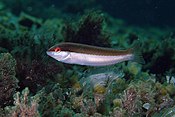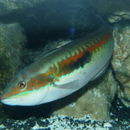Diagnostic Description
provided by Fishbase
Snout with 4-6 cephalic pores. Spiny rays flexible. No scales on head and on base of dorsal and anal fins. Vertebrae 25-26. Males: first 3 dorsal rays elongated, with an orange or red and black spot. Along the flanks, a- longitudinal zigzag orange or red stripe. Females and juveniles: a longitudinal large whitish stripe along flanks, a mid-longitudinal zigzag, dark brown stripe.
Life Cycle
provided by Fishbase
Females change sex to males before 18 cm TL. Sex reversal is completed in several weeks up to 5.5 months (Ref. 34185, 34255, 35388). Also Ref. 103751.
Morphology
provided by Fishbase
Dorsal spines (total): 8 - 10; Dorsal soft rays (total): 11 - 12; Analspines: 3; Analsoft rays: 11 - 12
Trophic Strategy
provided by Fishbase
Only old males deeper, occurs deeper during winter. Buries itself in the sand at night or when frightened. Acts sometimes as cleaner.
Biology
provided by Fishbase
Occurs in the littoral zone, near rocks and eelgrass beds. Usually found between 1-60 m, but old males stay in deeper water. Found in deeper waters during winter. Sometimes solitary, among rocks, often with numerous specimens in its immediate vicinity. Buries itself in sand at night or when frightened. Feeds on small gastropods, sea urchins, shrimps, worms, isopods and amphipods. Sexually mature when 1 year old. Protogynous species; females change sex to become males; specimen above 18 cm length are all males (Ref. 35388). Pelagic eggs (Ref. 4742).
Importance
provided by Fishbase
fisheries: minor commercial; gamefish: yes; aquarium: commercial; price category: very high; price reliability: very questionable: based on ex-vessel price for species in this family
Mediterranean rainbow wrasse
provided by wikipedia EN
The Mediterranean rainbow wrasse (Coris julis) is a small, colourful fish in the family Labridae. It can be found in the Mediterranean Sea and in the northeast Atlantic Ocean from Sweden to Senegal (though it is a rare wanderer to the southern British Isles).[3][2] Records of this species south from Senegal and the Cape Verde Islands are actually the closely related Coris atlantica.[2]
It feeds on amphipods, isopods, sea urchins, polychaete, shrimps, and small gastropods.[2]
Description

Female near
Livorno (Mediterranean population)
Like many wrasses, C. julis is a sequential hermaphrodite: all start in the smaller initial phase. These initial-phase individuals (both females and males) can turn into the larger secondary-phase males.[4] At a length of about 18 cm (7.1 in), all individuals are secondary-phase males.[2] The maximum length for the species is 25 cm (9.8 in). There is a marked difference in the appearance of the two phases. In the Mediterranean Sea, the secondary-phase male is green, blue, or brown, with white belly, a dark blue spot over the ventral fin, and a bright orange band on the side, while the smaller primary-phase females and males are brown with yellowish sides and white bellies.[5] Populations in the Atlantic differ in colour and genetics from the Mediterranean population, but are maintained in a single species at present.[1][4] If found to be separate, the scientific name Coris festiva (at present considered a synonym of C. julis) is available for the Atlantic population.
Habitat
It is typically found near the shore in places with seagrass or rocks. It is usually found at depths of 0–60 m (0–197 ft), but occurs as deep as 120 m (390 ft).[2]
References
-
^ a b Pollard, D.; Afonso, P. (2010). "Coris julis". IUCN Red List of Threatened Species. 2010: e.T187752A8621739. doi:10.2305/IUCN.UK.2010-4.RLTS.T187752A8621739.en. Retrieved 20 November 2021.
-
^ a b c d e f Froese, Rainer; Pauly, Daniel (eds.) (2019). "Coris julis" in FishBase. August 2019 version.
-
^ Dr Amanda Young. "Wrasse (British Seas)". British Marine Life Study Society. Retrieved 2 February 2017.
-
^ a b Aurelle, D., Guillemaud, T., Afonso, P., Morato, T., Wirtz, P., Santos, R.S.S., and Cancela, M.L. (2003). Genetic study of Coris julis (Osteichthyes, Perciformes, Labridae) evolutionary history and dispersal abilities. Comptes Rendus Biologies 326(8): 771-785.
-
^ Egidio Patrick Louisy Trainito, ed. (2006). Guida all'identificazione dei pesci marini d'Europa e del Mediterraneo. Milan: Il Castello. ISBN 88-8039-472-X.

- license
- cc-by-sa-3.0
- copyright
- Wikipedia authors and editors
Mediterranean rainbow wrasse: Brief Summary
provided by wikipedia EN
The Mediterranean rainbow wrasse (Coris julis) is a small, colourful fish in the family Labridae. It can be found in the Mediterranean Sea and in the northeast Atlantic Ocean from Sweden to Senegal (though it is a rare wanderer to the southern British Isles). Records of this species south from Senegal and the Cape Verde Islands are actually the closely related Coris atlantica.
It feeds on amphipods, isopods, sea urchins, polychaete, shrimps, and small gastropods.
- license
- cc-by-sa-3.0
- copyright
- Wikipedia authors and editors


